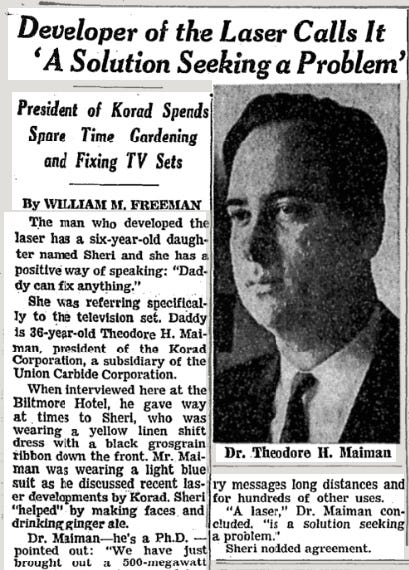Last week, I shared a summary of my EPIC paper conference presentation, Designing AI to Think With Us, Not For Us, offering the Problem-Solution Symbiosis Framework for designing human-centered AI. The framework addresses a fundamental challenge presented by generative AI (genAI): it’s a solution unlocking a new range of problem spaces to which it can be applied - all at unprecedented speed.
This is not the first time we’ve seen a disruptive innovation exert this solution-first push. I’ve previously shared how we needed Apple’s iPhone (solution) to unlock the potential of mobile-first use cases (problem spaces) - for instance, sharing photos via social media (e.g., Instagram), ridesharing (e.g., Uber) and mobile payments (e.g., Venmo). However, the timescale of prior solution space advancement was longer and more incremental. GenAI’s speed element is key to what makes it uniquely challenging to design for, and why we need a new framework.
In today’s episode, I go back to the first recorded use (that I could find) of the invention that inspired the phrase “a solution seeking a problem”, and explore what it can teach us about navigating genAI’s foundational challenge.
Laser Focus
What we now call the laser was first proposed around 1952, against a backdrop of the slowly-declining field of optics. These early systems, which operated below the visible light spectrum, were called a maser (Microwave Amplification by Stimulated Emission of Radiation). Numerous publications on the maser emerged over the next six years, until A. L. Shalow and C.H Townes proposed how you could theoretically extend the maser. T. H. Maiman experimentally verified their theories in 1961, generating coherent light by using a ruby crystal. The laser (Light Amplification by Stimulated Emission of Radiation) was born.
Maiman’s experiment led to a proliferation of laser types (e.g., the gas laser), and integration of the laser with other technologies. He is quoted in a 1964 New York Times article referring to the laser as, “A solution seeking a problem”.

By 1965, $30 million USD per year was being spent on laser research and development (about $295 million in 2024), leading Shalow to rename the maser acronym to Money Acquisition Scheme for Experience Research. The R&D seemed to be paying off: lasers were unlocking new problem spaces like eye surgery without anesthesia and new forms of “three dimensional photography” (i.e., holography). Applications in welding, chemical spectroscopy, and communication systems were on the near-term horizon.
Lessons from the Laser
The laser, like genAI, was a solution unlocking new problem spaces across diverse fields (e.g., laser eye surgery, holography). It didn’t emerge overnight. It was predicated by years of research and development. This is not unlike the introduction of the transformer model in 2017’s Attention is All You Need, which laid the foundation for today’s genAI frontier models like ChatGPT (not to mention the decades of AI research that came before). In this way, the ‘solution seeking problem’ phenomena is not unique to genAI.
However, lasers (or the internet, or iPhones, or other disruptive technologies) didn’t have the level of pre-existing infrastructure akin to cloud computing, data centers, and GPUs, from which genAI solution development could springboard. Combined with advances in transformer architecture, genAI technology had what it needed to accelerate - and proliferate across domains - at unprecedented speed. This rapid evolution challenges human-centered practitioners to sequence their problem space exploration simultaneously with solution development. The Problem-Solution Symbiosis Framework seeks to address this challenge, and offer practitioners tools to do so.
Read more about the framework here, as well as its accompanying toolkit to help you build genAI intuition as a team, map problem space ecosystems to uncover opportunities and risks, and intentionally offload cognitive tasks to genAI.
📣 A Call to Action
The next step for the framework is to get more teams using it to help them navigate genAI product development and marketing. Are you working on genAI tools, especially developing new ideas, features and market positioning ? Let’s chat about how we can partner on a case study. Reach out at stef@sendfull.com
Human-Computer Interaction News
A16Z’s Bi-annual Top 100 GenAI Consumer Apps Report: This report ranks the top 50 AI-first web products (by unique monthly visits) and top 50 AI-first mobile apps (by monthly active users). Compared to the March 2024 report, nearly 30% of the companies were new, and over half of the companies on the web list are focused on content generation or editing (image, video, music, speech, etc).
Using AI To Train Peer Counselors: Researchers from Stanford, Carnegie Mellon, and Georgia Tech present an AI-based model that offers feedback to novice peer counselors to improve their ability to help others in need. The work is published in a working paper accepted at the 2024 Association for Computational Linguistics conference.
AI ‘brain clock’ Provides Insights Into What Accelerates Brain Aging: Exposure to air pollution and living in a country with high socio-economic inequality were linked to a bigger gap between brain age and chronological age. Read the full Nature paper here.
That’s a wrap 🌯 . More human-computer interaction news from Sendfull next week.





